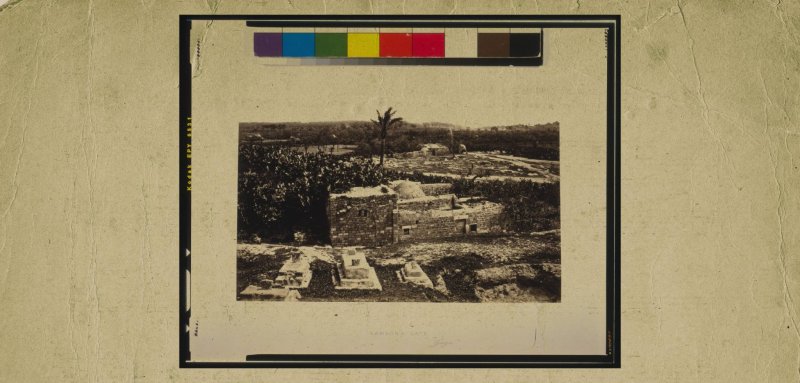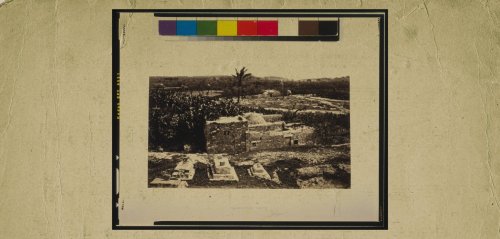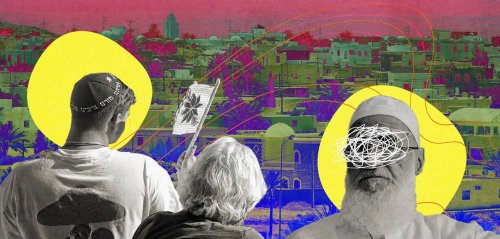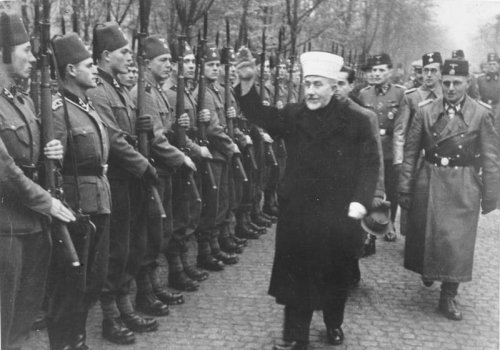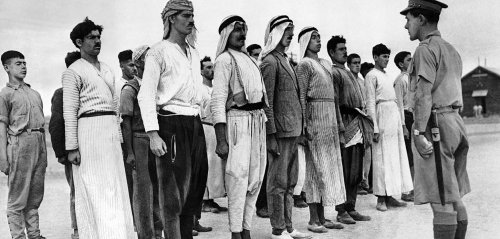The current Israeli war on Gaza has resulted in widespread destruction and an unprecedented escalation. The situation was not always so violent; years ago, the Palestinian and Israeli sides lived side by side, coexisting, and commercial interests and religious freedom flourished. The region became one of tolerance and diversity – the ‘Jews of Gaza’ even established a synagogue.
In his paper The inscription of the Sabean truth: The geography of the Torah Is not in Yemen, academic Fekri Al Heer remarks that “Yesterday's Jews were Arabs from us and among us, but today's Jews are not so, and they have no homeland in Palestine.” In his book Ithaf Al-Azza in the History of Gaza, Sheikh Othman Al-Taba'a explains that Gaza resisted the expansion of the Israelites (Banu Israel) for years, even during the reigns of Solomon and Hezekiah, when the ancient Jewish kingdom was at its peak.
Al-Taba'a continues, stating that the Jews entered Gaza in 96 AD/CE following the withdrawal of Egyptian soldiers from the region. They seized the city for a year until they were able to enter, burning its buildings and killing its residents. In modern times, Israel has brought Gaza under its control twice: the first time, for a few months in 1956 during the tripartite aggression, and the second time in 1967, for much longer, finally only withdrawing in 2005 after Ariel Sharon implemented a withdrawal plan.
According to the book History of Gaza, the entry of Islam into Palestine was a blessing for the Jews. During the 7th and 8th centuries, "many Jews" lived in Gaza. Since Islam prohibited the production of wine, the Jews of Gaza monopolized the trade for a long time
Fekri Al Heer discusses an ancient inscription that reveals information about Jewish life in Gaza. The votive inscription, B-L Nashq Demirjian 1, was discovered by historians André Lemaire and François Bron in Yemen’s Jawf region, and is written in the Sabean alphabet. The text details the Yemeni forces’ campaign against the Arab Bedouins, who had attacked Yemeni tribes.
According to the inscription, the Yemeni campaign wanted to punish the Arabs of the ancient Kingdom of Lihyan (northwest Hijaz today). They also sought to punish allies of the Arab Bedouins, some of whom were Jews in Gaza.
The Islamic era: Revival of the wine industry!
In his book History of Gaza, Aref Al-Aref labels the start of Islam in Palestine as a blessing for the local Jews. According to the author, in the seventh and eighth centuries, many Jews lived in Gaza. Since Islam prohibited the production of wine, the Jews of Gaza monopolized the trade for a long time.
Al-Aref shares examples of some prominent Jews of Gaza, including the poet Yosha Yarbi Nanan, a member of the Jewish religious court. In 1026 AD/CE, he authored a book lamenting the death of his son in Gaza. Another figure was Rabbi Moses Hankash Al-Ghazzi, who served as the leader of the Jewish community in Gaza.
Despite this, it seems that the Jewish community in Gaza was exceedingly small, as it did not catch the attention of the traveler Benjamin of Tudela on his visit to Palestine around 1173 CE/569 H. He did not make mention of a Jewish presence in Gaza.
In his book Jews in the Eastern Mediterranean, Dr. Ali Al-Sayyid recounts the experience of Rabbi Obadiah Garda Bertinoro, an Italian Jew who migrated to Jerusalem in 1488 CE/893 H. and settled there until his passing. During his time in Palestine, Rabbi Obadiah wrote three letters that several orientalists consider valuable documents detailing the conditions of Jews in Palestine, while the region was under Mamluk rule.
Rabbi Obadiah recalled visiting some Jewish friends in Gaza, “We spent four days in Gaza, where a prominent Jewish immigrant from Germany named Rabbi Moses of Prague resided.” He added, “He invited all the Jewish elders to have a meal with us at his home, where he presented us with an array of pastries baked from grapes and fruits. We also enjoyed various drinks that brought us immense joy.”
Describing Gaza as a “spacious and beautiful town, comparable in size to Jerusalem,” Rabbi Obadiah emphasized that Gaza lacked protective walls against attackers. His impressions of Gaza were also infused with convictions from the Torah convictions, explaining, “I saw with my own eyes the ruins of the buildings demolished by Samson over the heads of the Palestinians.”
In 1481 CE, Rabbi Mishulan ibn Manahem visited Gaza, where the “Jewish elders in Gaza prepared a warm welcome” for him, led by Rabbi Moses of Prague, who had previously hosted Obadiah. Rabbi Moses enjoyed a good degree of wealth that enabled him to purchase a house and farm in Gaza. That same year, an Italian-Jewish tourist named Misho Lam, visited the Gaza Strip and stayed in one of its bustling inns filled with caravans of tourists. In his testimony of his visit, he expressed the freshness and purity of the city's air and the richness of its fruits.
According to Obadiah, Gaza accommodated more Christians and Jews than Jerusalem, estimating the presence of about fifty to sixty Jewish families that owned a “small, beautiful temple surrounded by houses and their fields.”
According to the accounts of both travelers, Jews in Gaza were fully integrated into Arab society and there was remarkable coexistence. Muslims distributed food as charity at the tombs of the prophets Abraham, Isaac, and Jacob. Jewish women even wore veils and freely visited sacred places, and both communities adhered to similar customs regarding food, drink, and even sleeping habits.
Jews in Gaza were fully integrated into Arab society. Muslims distributed food as charity at the tombs of the prophets Abraham, Isaac, and Jacob. Jewish women even wore veils and freely visited all holy sites, and both communities adhered to similar customs.
The Ottomans
Obadiah's claim that the number of Jews in Gaza surpassed that of Jerusalem is in line with the Ottoman census of Jerusalem in 1525 CE/932 H, which recorded 115 Jews. Some were from Gaza, having migrated and settled in Jerusalem, according to Muhammad Adnan Al-Bakheet and Nawfan Raja in their book The History Of The Levant Greater Syria.
According to Aref Al-Aref, a Jewish Gazan expressed his admiration for the city through art, creating a painting in 1598 CE titled Gaza: Samson's Land... A Beautiful City. By the time Napoleon occupied Gaza in 1799 AD, most of the Jews had left the city, and by 1911, the Jewish community was nonexistent, and the synagogue was long abandoned. When Ibrahim Pasha occupied Gaza in 1831, he ordered the construction of the Ashkelon wall using the ruins of the Jewish synagogue.
For a period after 1880, Jews began to settle in Gaza again. When Rabbi Yehi Thiel Brill visited the city after two years, he found a thriving Jewish community that excelled in trade, especially in the business of the Colocynth fruit (bitter apple), which from its root they produced and exported medicine. The Rabbi visited the Jewish Quarter and saw Hebrew inscriptions on the doors of Jewish homes bearing religious calls to God.
The British Mandate: Waves of disputes
According to Dr. Suhaila S Shalabi in her book The Beginnings of the Arab Awareness towards the Zionist Project Dangers, 1897-1917, the year 1908 marked the beginning of organized Zionist settlement activity on Palestinian land. This involved the expansion of land purchases and preparation to transform them into Jewish colonies. This heightened tensions in Palestine, leading to multiple armed confrontations between Arabs and Jews. One such clash occurred when residents of the village of Kafr Kanna attempted to seize land in Gaza that the Zionist settlement association had managed to take over.
In 1908, the Jewish population of Gaza was 160. At the outbreak of World War I, around 30 Jewish families, including the Alqaiim, Weissman, and Arowas families, settled in Gaza, and engaged in grain trade.
In August 1911, the British Foreign Office compiled a report addressing the expansion of land purchases by Jewish groups in Gaza, including a plot of land bought by Jews from the Ramilat Arabs in Gaza. In response, the Al-Muqtabas newspaper published a letter in distress from a Gazan stating, “The flames have spread among us, and the Arabs are rushing to get rid of their lands for the sake of the shiny yellow (gold).” The Gazan concluded his letter with an appeal to the Jerusalem governor to intervene and “extinguish this flame before it spreads further.”
According to historic accounts, Gaza accommodated more Christians and Jews than Jerusalem did, estimating the presence of about fifty to sixty Jewish families that owned a “small, beautiful temple surrounded by houses and their fields.”
Aref Al-Aref states that “Arabs began to view Jews with hostility after numerous revolts against Jews took place in Palestinian land, in which all of Gaza participated. This was especially true for the 1929 uprising, which further complicated the position of the Jews. Consequently, around 60 families left Gaza because of this, and none of them returned after that date.”
However, it seems that Jewish displacement from Gaza was not complete, as references to their presence continued until relatively recent years. Months before the outbreak of the July 1952 revolution, according to Muhamed Naguib in his memoir, I Was President of Egypt, Hussein Serry Amer, the Border Guard commander, used to sell petrol, ammunition, and the remnants of World War II to “a group of Jews in Gaza” in the western desert.
The Free Officers considered these activities a major betrayal and devised a plan to assassinate Amer. This was the only political assassination attempt that the Free Officers movement planned, causing hesitation among their leaders, including Gamal Abdel Nasser. In his book The Philosophy of the Revolution, Abdel Nasser admitted that he thanked God when he read the next day's newspapers reporting that Amer was unharmed after surviving an assassination attempt.
To this day, the Jewish Quarter still exists in Gaza, and is now occupied by Arab families. This neighborhood includes a cemetery containing numerous Jewish families who could have continued their harmonious life with their Muslim neighbors side by side, as they had in the past, if it were not for the creation of the state of Israel!
Raseef22 is a not for profit entity. Our focus is on quality journalism. Every contribution to the NasRaseef membership goes directly towards journalism production. We stand independent, not accepting corporate sponsorships, sponsored content or political funding.
Support our mission to keep Raseef22 available to all readers by clicking here!
Interested in writing with us? Check our pitch process here!
